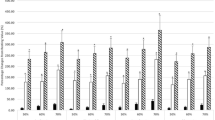Summary
Reticulocyte count comparisons were made on ten trained and ten sedentary college males before and immediately after heavy exercise and following 15 min of recovery. No significant differences occurred within or between groups; in fact, all means were within the normal range. Previous findings were discussed. It was concluded that a physiologically significant increase in reticulocytes does not occur as a result of exercise or training and therefore can not be a mechanism for increased maximal oxygen uptake.
Similar content being viewed by others
References
Berger, H., C. Zuber, andP. Miesoher: Reduction of methaemoglobin to haemoglobin in the ageing red cell. Gerontologia4, 220 (1960).
Brewer, G. J., A. R. Tarlov, R. W. Kellermeyer, andA. S. Alving: Hemolytic effect of primaquine: XV The role of methemoglobin. J. Lab. clin. Med.59, 905 (1962).
Broun, G. O.: Blood distruction during exercise III. Exercise as a bone marrow stimulus. J. exp. Med.37, 187 (1923).
—: Blood distruction during exercise IV. The development of equilibrium between blood destruction and regeneration after a period of training. J. exp. Med.37, 207 (1923).
Darling, R. C., andF. J. W. Roughton: Effect of methemoglobin on the equilibrium between oxygen and hemoglobin. Amer. J. Physiol.137, 56 (1942).
Edwards, M. J., andN. C. Staub: Kinetics of O2 uptake by erythrocytes as a function of cell age. J. appl. Physiol.21 173 (1966).
Gerald, P. S.: The Hereditary Methemoglobinemias. The Metabolic Basis of Inherited Diseases. New York: McGraw-Hill 1960.
Jung, F.: Alter Hämolytische Resistenz und Methämoglobingehalt der Erythrozyten. Dtsch. Arch. klin. Med.195, 454 (1949).
Matthies, H.: Methämoglobin-Rückbildung in Reticulocyten. Naunyn-Schmiedebergs Arch. exp. Path. Pharmak.229, 331 (1956).
Meyering, C. A., A. L. M. Israels, T. Sebens, andT. H. J. Huisman: Studies on the heterogeneity of hemoglobin: II. The heterogeneity of different human hemoglobin types in carboxymethyl cellular and Amberlite IRC-50 chromatography: Quantitative aspects. Clin. chim. Acta5, 208 (1960).
Patriarca, L., and G. C.Topi: Hematological alterations in strenuous work. Medicina dello Sport, Torino1 (1967); as abstracted in: J. Sport Med. (Torino)7, 231 (1967).
Waller, H. D., B. Schlegel, A. A. Muller u.G. W. Lohr: Der Hämoglobingehalt in alternden Erythrocyten. Klin. Wschr.37, 898 (1959).
Wintrobe, M. M.: Clinical Hematology, 5th edition. Philadelphia: Lea and Febiger 1961.
Author information
Authors and Affiliations
Rights and permissions
About this article
Cite this article
Londeree, B.R., Allaire, T. Reticulocyte counts before and after exercise: Trained vs. sedentary. Int. Z. Angew. Physiol. Einschl. Arbeitsphysiol. 27, 226–229 (1969). https://doi.org/10.1007/BF00696260
Received:
Issue Date:
DOI: https://doi.org/10.1007/BF00696260



